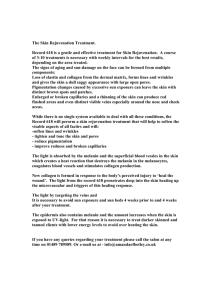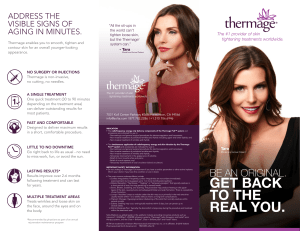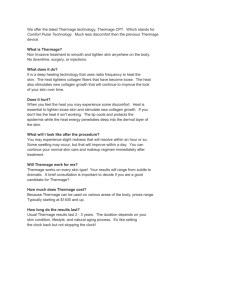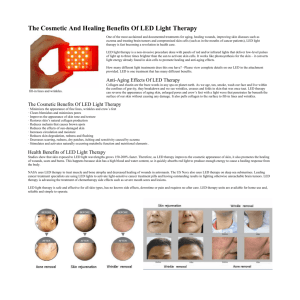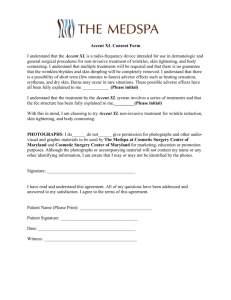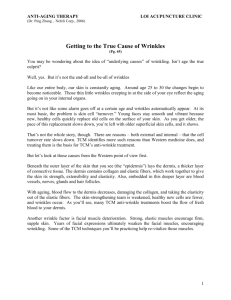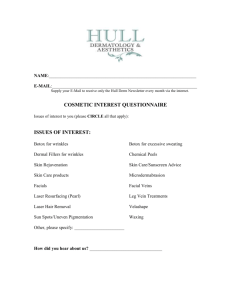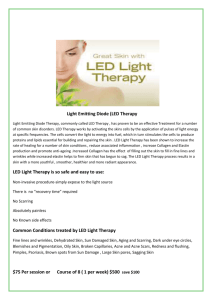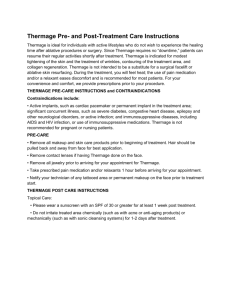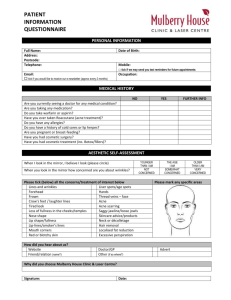RF device`s steady vs. pulsed waves heat the way to less painful
advertisement
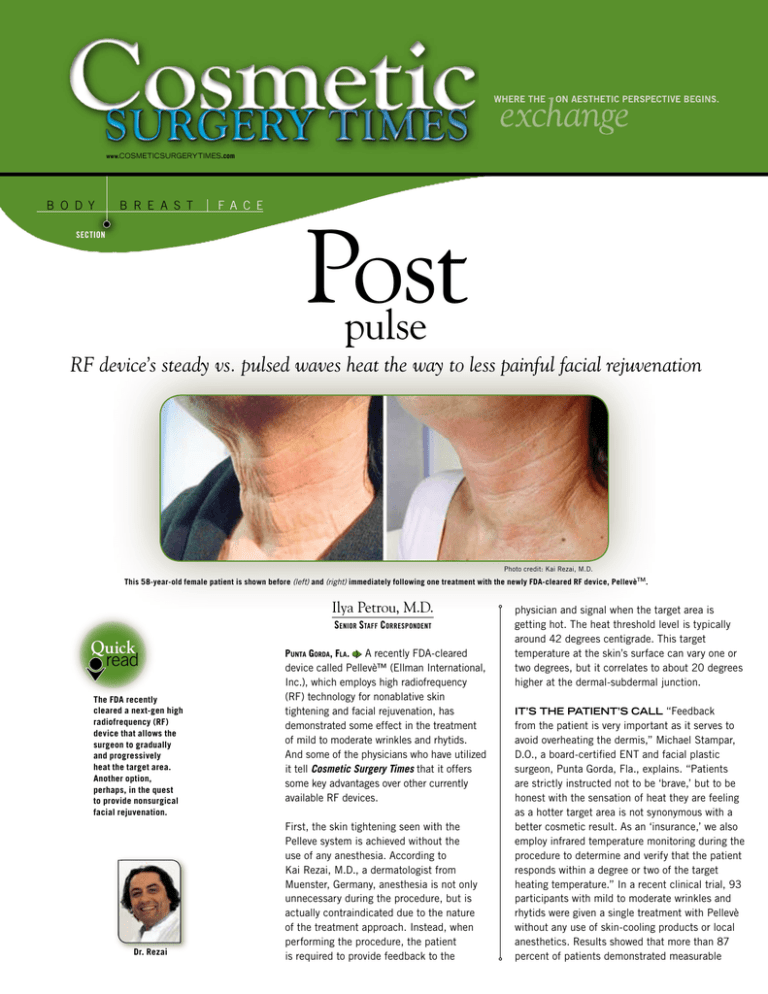
www.cosmeticsurgerytimes.com b o d y b r e a s t section f a c e Post pulse RF device’s steady vs. pulsed waves heat the way to less painful facial rejuvenation Photo credit: Kai Rezai, M.D. This 58-year-old female patient is shown before (left) and (right) immediately following one treatment with the newly FDA-cleared RF device, Pellevè™. Ilya Petrou, M.D. S enior Staff Correspondent Quick read The FDA recently cleared a next-gen high radiofrequency (RF) device that allows the surgeon to gradually and progressively heat the target area. Another option, perhaps, in the quest to provide nonsurgical facial rejuvenation. Dr. Rezai Punta Gorda, Fla. � A recently FDA-cleared device called Pellevè™ (Ellman International, Inc.), which employs high radiofrequency (RF) technology for nonablative skin tightening and facial rejuvenation, has demonstrated some effect in the treatment of mild to moderate wrinkles and rhytids. And some of the physicians who have utilized it tell Cosmetic Surgery Times that it offers some key advantages over other currently available RF devices. First, the skin tightening seen with the Pelleve system is achieved without the use of any anesthesia. According to Kai Rezai, M.D., a dermatologist from Muenster, Germany, anesthesia is not only unnecessary during the procedure, but is actually contraindicated due to the nature of the treatment approach. Instead, when performing the procedure, the patient is required to provide feedback to the physician and signal when the target area is getting hot. The heat threshold level is typically around 42 degrees centigrade. This target temperature at the skin’s surface can vary one or two degrees, but it correlates to about 20 degrees higher at the dermal-subdermal junction. It’s the Patient’s Call “Feedback from the patient is very important as it serves to avoid overheating the dermis,” Michael Stampar, D.O., a board-certified ENT and facial plastic surgeon, Punta Gorda, Fla., explains. “Patients are strictly instructed not to be ‘brave,’ but to be honest with the sensation of heat they are feeling as a hotter target area is not synonymous with a better cosmetic result. As an ‘insurance,’ we also employ infrared temperature monitoring during the procedure to determine and verify that the patient responds within a degree or two of the target heating temperature.” In a recent clinical trial, 93 participants with mild to moderate wrinkles and rhytids were given a single treatment with Pellevè without any use of skin-cooling products or local anesthetics. Results showed that more than 87 percent of patients demonstrated measurable “ We found that, by bringing the temperature up gradually, facial rejuvenation procedures do not have to hurt to work. ” — Michael Stampar, D.O. Punta Gorda, Fla. and immediate positive cosmetic outcomes in a blinded assessment of skin laxity and wrinkle improvement — with a continued response six months after treatment. dual wave effect The high frequency radiowaves have a two-pronged effect. First, they induce a denaturization and subsequent contraction of the collagen fibers in the target area; secondly, they cause micro-scarring in the dermis, proven by histology. These microscars produce fibroblasts, which, in turn, lead to neocollagenesis. Macroscopically, a tightening can be seen immediately following the procedure, but this tightening continues to improve over two to three months as new collagen forms, say the physicians who have utilized the device, resulting in thicker, plumper skin. “If you injure the dermis to that degree, you trigger enough of an injury to trigger that healing response that lays down new collagen,” Dr. Rezai explains. “If you do not get to that threshold, you will not help the patient, and if you get to that threshold too fast, you may cause pain and even burn the targeted area.” Depending on the severity of the wrinkles and rhytids, Dr. Rezai notes that although the cosmetic effect of Pellevè can be seen after the first treatment, usually the patient will receive two to three treatments. Results can last for up to two years, depending upon how fast patients’ natural collagen breaks down, with maintenance treatments indicated every one or two years. steady state According to Dr. Stampar, the Let there be heat Whether monopolar or best way to make RF technology work is to deliver the high frequency energy continuously rather than in a pulse form so that treatments are not dose-limited. With Thermage, Dr. Stampar says, he used a pre-designed algorithm dictating a certain number of pulses per area and a certain number of passes, making it difficult to treat the patient with “their” dose. By contrast, he says, the Pellevè technology effects a gradual and progressive heating of the target area, allowing the physician to “ratchet down” the connective tissue bands with each pass until maximum desired contraction is achieved with little concern for pain or excessive thermal injury. bipolar, both types of RF energy generate heat the same way and at the same subdermal level, which can be verified by infrared imaging. Energy is passed through the skin at a very low resistance, but as it reaches the fat layer, the resistance increases, creating heat. “The subdermal level is where the majority of the collagen is that we are trying to target, denature and remodel,” Dr. Stampar explains. “As the heat spreads more superficially in the dermis, you are getting closer to effacing wrinkles. In my infrared images using my Thermage device, Thermage did not do this, as the cooling effect in Thermage freezes the skin so densely that it does not allow any upper dermal effect, resulting in little cosmetic effect on wrinkles.” (unsponsored physician investigation) “You have to be very careful with a pulsed device because you cannot be sure whether that next pulse will be too much and cause too much heating, translating into too much damage such as necrosis and subsequent scarring,” Dr. Stampar advises. “The line between heating tissue enough to cause a controlled injury and too much heat causing damage is a very fine line to walk and that is where patients can get injured with a pulsed device. By heating the tissue gradually, the patient will not let you go beyond that threshold because they will signal to you when the target area gets uncomfortably hot. The accuracy of their signaling again can be backed up through the infrared temperature monitoring, which acts as a kind of insurance policy.” © Excerpted and Adapted from Cosmetic Surgery Times, September 2009 According to Dr. Rezai, CO2 lasers can achieve similar results as this new device, however, due to the much longer downtime, in his opinion, Pellevè is the better choice. In addition, he notes that, although Thermage and Pellevè use the same technology and technique, Thermage is comparatively more expensive because the singleuse treatment heads are discarded following a session. � Disclosures Drs. Rezai and Stampar are paid independent contractors for Ellman International, Inc., but have no financial interest in the company and funded their own research. Reference Rusciani A, et al. Nonsurgical tightening of skin laxity: a new radiofrequency approach. J Drugs Dermatol. 2007;6:381-386. Printed in U.S.A. CC09127-INT
